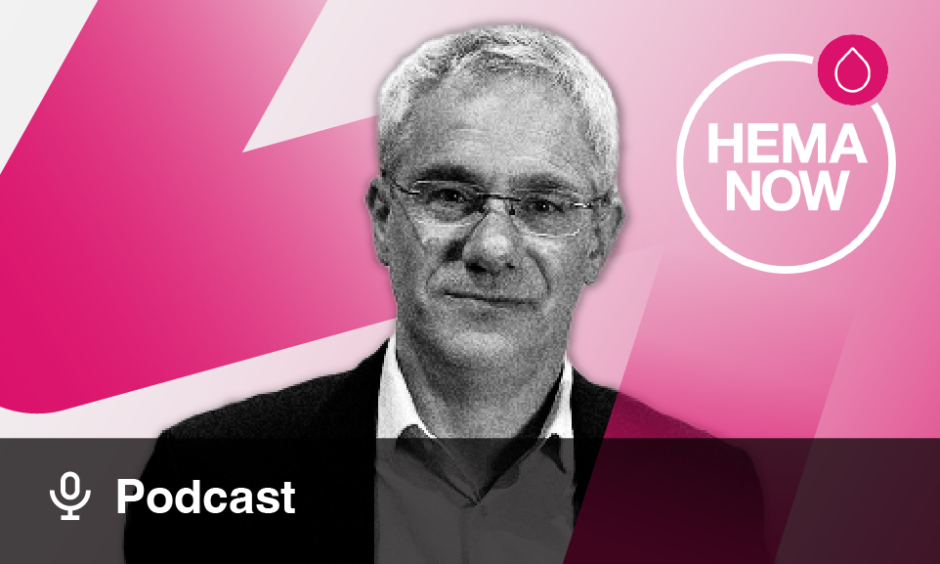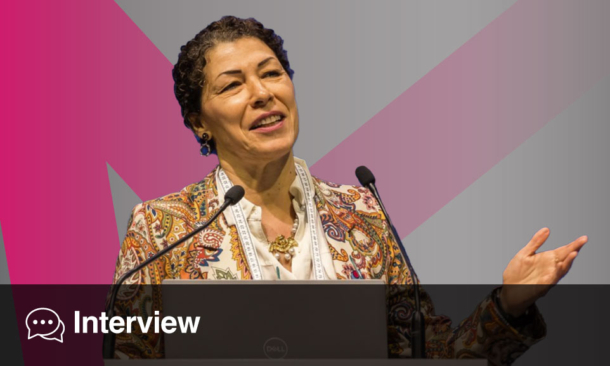Following your research fellowship in medical oncology at the Johns Hopkins Oncology Centre, Baltimore, Maryland, USA, what drew you to the combined practice of haematology and oncology?
We are talking about 35 years ago, and some of what drew me to the practice is still true today. There were two major aspects of cancer that were critical: 1) it was an overwhelmingly incurable disease; this has changed over the past 35 years, with many cancers now curable and other treatments improving by the day. But then there was a great need as it was universally a fatal disease. There was a great need for research that improved outcomes. 2) It represents a fascinating area of cellular control. Having an interest in both the biology of disease and biology and normal physiology of cellular changes and genomics, combining the practice of both blood cancers and how to take care of it, became of great interest and importance to me. I would still do the same thing now, 35 years later, because there is still so much more to understand. The research needs and clinical needs became unifying factors for me to practice haematology and oncology as a joint endeavour.
You are Associate Director of the Jerome Lipper Multiple Myeloma Center at the Dana Farber Cancer Institute, which is currently recognised internationally as one of the top three hospitals specialised in oncology. What do you think other hospitals could learn from the approach taken at Dana Faber?
To summarise the attraction and the strength of Dana Faber I need three words: bench to bedside. I believe what we excel in is outstanding laboratory science: finding new pathways, new molecular and genomic changes, etc. But that’s not enough; we need to bring those discoveries to patients and take it from bench to bedside. So that is what we excel in: finding new approaches that can then be translated into successful treatments, which can lead to curative and improved outcome. Then, there is also the component of going the other way: from bedside to bench. When patients respond we need to find out who responds so that we can do it better, and who does not respond so that we can find those features and improve on them or come up with solutions to overcome resistance mechanisms. Essentially, bringing it back to bench to understand the patient’s behaviour and the disease behaviour and improve upon it. That has been the strength and the hallmark of what Dana Faber does: taking successes and treatments to the patient and what counts for the patient. This is the formula that a lot of centres could use to improve upon treatments and therapies.
What was the rationale for the establishment of the Myeloma Initiative at Veterans Administration Hospitals and what outcomes have arisen from this?
The veteran population are a unique population; they are outstanding individuals who have served the country, and over the years they have different needs. I have been connected to the veterans hospitals for over two decades and I am very happy and proud to be part of the care of veterans. They deserve the best. Their unique features drove us to establish the initiative and collaborate across all the large veteran hospitals in the USA, to provide them an improved access to care, drugs, and a better understanding of their needs. For example, there is a higher proportion of African American patients who are veterans and there is a higher proportion of veterans who are of older age, who took part in World War II and before that. There is also a need for focused clinical research, which has encouraged us to combine our efforts across the Veterans Administration to learn from each other and develop treatments that are more unique to them.
Could you outline the key research findings and wider relevance of your recently published policy review article ‘Treatment of Relapsed and Refractory Multiple Myeloma: Recommendations from the International Myeloma Working Group’?
What this publication highlights is the success in myeloma so far. There have been 14 new drugs approved in the last 15 years. This has made the treatment of myeloma much better but also more complicated. How do we combine the drugs? What sequence do we use? What dosages do we use? This publication begins to address this. Also, how do we treat relapse and refractory myeloma patients? The initial treatment is more or less standard, with a four-drug regimen, etc. However, later on in treatment we have 10 or more drugs to use and they need to be used appropriately, in the right patient setting, taking into account various features. These features include patient-specific features such as their age, their toxicity, their comorbidities, and their financials, but more importantly their logistical needs and how they have responded to previous treatments. This all needs to be synthesised into how we utilise these drugs. This particular publication combines these aspects. The problems we have are problems of success; however, we need to realise that there is still more work to do. Patients do relapse, even after taking the drugs available, so we need to find new treatments and new approaches that can be utilised more appropriately. The most recently approved agent is a chimeric antigen receptor T cell (CAR T), which is completely opening new doors for treatment of myeloma.
You currently have more than 400 peer-reviewed publications and book chapters to your name, primarily for your research in multiple myeloma. What do you believe to be the current gaps in literature and what topics warrant greater attention?
We have incredible access to technology compared to what we used to have. A whole-genome sequence can be done in less than a week and we can have all the data about the genome. However, we still have big gaps in our knowledge about what causes myeloma, what causes the progression of early-stage monoclonal gammopathy of undetermined significance and smouldering myeloma to myeloma. What are the features causing the progression? The genomic changes that are taking place is because of the genomic instability; that is what causes myeloma to become resistant. We need to understand the mechanisms that might be helping the cancer to continue growing. And then more important are the resistance mechanisms and the immune changes, which are important because the immune system, as we are beginning to understand, has such a tremendous ability for impact and we need to learn how to harness that. So there are a number of gaps in our knowledge about how cancer cells grow and how the micro-environment supports this growth. There is the old ‘seed versus soil’ theory: cancer is the seed, but it needs the right soil to grow. We need to understand and target both to optimally control the disease. I think that is the gap that are we are beginning to understand, but we have a lot more to do to make it a very curable disease. I believe we have taken the ultimate steps to reaching this goal.
A major focus of your laboratory is the development of immunotherapeutic agents, such as chimeric antigen receptor-engineered T cell therapies, to target the evasion tactics of multiple myeloma. Could you tell us how this works and summarise the current stage of the research into immunotherapy and immuno-gene therapy?
My laboratory has been focused on understanding the immune changes in myeloma and developing immune-based treatments for the last 30 years. The most-recently approved CAR T agent, the first truly immune-directed treatment, is the BCAM (B-cell maturation antigen)-directed CAR T cell immunotherapy for myeloma and is the first to become commercially available to patients. What is more, the results of this study and similar studies are so incredibly exciting that they have opened up a totally new possibility for the prognosis of this cancer. I think I would call this a last step to curing this disease. What is done here is that we use the power of the immune cells to get rid of what is not needed in or foreign to the body. We take the immune cells and genetically modify them to introduce certain features that allow the immune cells to identify specifically the cancer cells, nothing else. This allows the immune cells to bind to or come close to the cancer cells and, in the process, immune cells identify the cancer cells and kill them. In that process, the immune cells divide and expand further to become stronger and kill more cancer cells. So, we give these features to the immune cells and they do what we expect and hope they will do, which is to kill cancer cells in large number. And there are many more similar drugs coming out. They work in patients who are on six different lines, on average, of treatment. Where we traditionally would expect no treatment to give more than a 20% response rate or so, which would last for 2–3 months, this treatment now gives us an 80–90% response rate that last for 12 months and beyond. So, it is incredibly effective as the last treatment where nothing else is possible. Now we are beginning to introduce it in the earlier stages where we expect the responses to be even greater and the durability, hopefully, even longer. And when we witness a subgroup of patients who do not eventually relapse, it will be a population that we can save and possibly cure using this treatment. We are not ready to say that yet, but I think the treatment has the potential to get us there.
In October 2020, you co-authored a paper evaluating the impacts of the COVID-19 pandemic on the management and treatment of multiple myeloma. Could you explain the pivotal messages of this study?
There are many messages from this study. Firstly, this particular study was truly an international effort. Investigators from many countries in North and South America, Europe, and Asia participated to give their data very acutely, in one effort. Everybody joined hands to understand what COVID-19 does to patients with myeloma. Secondly, it was early days and we did not have a vaccination and we did not understand the disease as well as we do today. But it told us that patients with myeloma have a specific susceptibility to a more severe form of COVID-19 and there was a high mortality in the early days in these patients. This has now changed with the vaccine roll-out and other things. But there was something else: it told us that immunosuppression, which we observe in myeloma, is part of the immune problem. It plays a critically important role in controlling COVID-19. Therefore, we eventually came up with some guidelines that we shouldn’t not treat patients with myeloma because of COVID-19, which was the initial knee-jerk reaction. In fact, the point we came out with was that we actually needed to treat myeloma effectively so that the immune system would become better and thereby there would be fewer issues with COVID-19. And finally, it became clear over time from that publication that patients with myeloma, by not having normal immune systems, may or may not have an adequate immune response to the vaccine and that we still need to be careful. We need to measure the vaccine responses and manage patients with myeloma in a very specific way to make them safe from the current pandemic. That initial international effort taught us a lot about how to do an international study but also how to overcome a threat like COVID-19 in patients with an immunosuppressed disease.
You have expressed the importance of optimally defining risk in multiple myeloma. Could you highlight the potential benefits of revising the current definition, especially in relation to the treatment received by patients?
Over the years we have defined high-risk myeloma and those patients with myeloma who may not have such a good outcome, and then we have gone after those features to try to overcome it. So every year we find a high-risk disease and develop new treatments, which can better treat high-risk patients with those high-risk features. And by that we then identify patients with a new, high-risk feature. So, the treatments can overcome the risk in a setting where new features appear. I think risks are dynamic, not because they change, but because our treatments change, and so with each new treatment that we develop, we have to redefine what the risk is. This has happened for the past 30 years. There was a time when chromosome 13 deletion was a risk for myeloma; today we do not even care for it because all current treatment can overcome this. There was time when t(4;14) myeloma was considered a very high-risk myeloma; now the treatments we use can overcome the high risk in those patient populations. We have our current risk stratification: 17p deletion is not good myeloma at the moment, along with a few others, and we are developing treatments to overcome this. So, I think we have to remember that with changing treatments, risk features are dynamic, and we have to evolve with the treatment evolution to identify patients who do not have as good an outcome and specially treat them to overcome those features.
Are there any innovations on the horizon in the field of multiple myeloma treatment that you think are particularly noteworthy, and what barriers to progression still need to be overcome?
One of the new understandings in myeloma is the minimal residual disease (MRD) that we and others have worked on. MRD is a situation where we are able to identify 1 myeloma cell in a million cells, which is 10,000-fold better than what we do today, or what we did yesterday. Getting patients to a state of MRD negativity and developing treatments for that is our goal. This is also going to identify a successful treatment much more quickly as it gets accepted as a surrogate for the current survival outcomes. There are many treatments in the pipeline that are exceedingly exciting and have great potential; a lot of them are immune-based, and besides the CAR T cells, we have bispecific antibodies and immune response modifiers. We have newer agents and newer targets that can affect protein catabolism. Then, we have targeted treatments for various myeloma subgroups and these are all very exciting, especially the immune-based methods. Combined with the newer methods of measuring myeloma, MRD and the others will ultimately give us the best outcome for these patients
Since your appointment as President of the International Myeloma Society (IMS), what has been your proudest achievement?
I think what has been the most gratifying so far is the society’s ability to fund research for multiple myeloma. We have two efforts that I am very proud of and I think will make a big difference. One is the ‘Career Development Award’, which is specially devised to support the careers of young investigators, the ‘new blood’ that can be fostered that will be the future of myeloma research. Second, with great philanthropic support from the Paula and Rohger Riney Foundation, we have launched the ‘Translational Research Award’, which gives significant funding to myeloma research to develop translational efforts to bring about drugs that can directly benefit new drugs and new treatments, which can benefit patients with myeloma directly. Truly translational research and not just laboratory research. And this is also directed at attracting investigators from other cancer fields to use their success in lymphoma or leukaemia and apply that to myeloma and enrich the efforts that we have. So, we have funded both these efforts this year and we plan to do this for long period of time. The society has become one of the largest funders of myeloma research. I am very proud of these accomplishments of the society.







